April 22, 2024
Airline Service:
Simplifying The Customer Experience
It Is Happening.
The DOT Secretary has mounted his soapbox and declared that USA airlines are systematically and consistently abusing consumers. He’s asked state attorneys-general to help him corral this aberrant sector of the national economy.
He has declared airlines to be consumer-abusing scofflaws. The industry needs to react aggressively. Not to this guy, but to their passengers. Get them on the airline side of the equation.
It’s Not Like Buying From Amazon. Air travel is unique as a product in that the user enters into a relationship where he or she uses it almost completely under the control of the seller, and largely to subject to rules and requirements outside of the consumers’ control.
The buyer is not in control. Think about it: there are a lot of “or else” instructions. Comply or you don’t get the product, which is arriving at Spokane.
It’s based on direct orders, albeit somewhat with a public relations veneer of seeming to make the trip a great experience to look forward to. Nice try. These are not suggestions from the crew but are direct orders. But it’s all a situation where rules must be followed, starting with safety, and going into issues involving the sub-product the customer may have agreed to buy.
The first category is regulatory. After that, it’s the airline that makes the decisions on compliance or non-compliance with their rules.
The hard regulatory stuff is easy to understand, if sometimes imparted like a Marine Corps DI. Like, to keep the seat fully upright during takeoff, to relinquishing personal goods (a.k.a .checked baggage) to other people, to being instructed when to get on the plane, specific carry-on instructions, watching a video that seems to make light of the very distant potential of needing to get off the plane fast, lest one become a crispy critter in economy.
You know, the hard and fast safety stuff. How it’s communicated is critical to customer service, but it must be followed. No exceptions.
People don’t like to be trapped in a metal tube and know that at the bottom line they are required to follow orders. It’s a natural human response, but essential to safety. Deal with it.
Then comes the soft parts of the air service product purchase. At most airlines, it’s a giant menu of varying accessories and rules to the basic product of transportation. Differing fare levels, each with varying levels of amenities, like seat selection, boarding priority, carry-on rules, legroom, location of seat in the cabin, etc.
Now comes the acid test of airline customer service: failure remediation. When the flight cancels or is delayed, remediation is necessary. This is as intrinsic to the air travel product as is fueling the aircraft, but a lot more complex to deal with, particularly in cases where the consumer feels he’s been put through enough uncertainty or perceived mistreatment loses composure.
This is where the seeds are sown to get people like Buttigieg involved.
There are two paths that the USA airline industry needs to pursue to avoid more inept DOT intervention that is based more on lore than on reality.
Refocus on Customer Service As A Priority. Having people around the airport to deal with customer issues is really, really expensive. And so is having to have pilots in the cockpit.
In reality, both of these are critical to the air transportation product. Unfortunately, a number of airlines have clearly decided that they aren’t going to pony up to handle silly issues coming from their customers.
One airline reportedly closes its customer service counter an hour before flight. Tough, passengers. You should have been here earlier. Others have completely eliminated any customer service phone lines. Do it by text, they say, which is an enormously amateur and arrogant approach to taking care of that family of four that just found out the flight is cancelled, and there’s nobody to talk to at the airport.
Rethink how much money is saved farming out customer processing to mercenary vendors. Yup, getting bids for handing check-in and airport services from outside companies is a great way to save money. And reducing administrative hassle. It’s just a three-year contract, which will be re-bid. Wow, we won’t need to deal with personnel issues or, god forbid, a union drive.
The truth is that this puts airline customers in the hands of staff that don’t work for the airline, have no career path, are paid low wages, and have zero interest in going out of the way for passengers. They are not on the airline’s team. So, when things go operationally south, the customers are pretty much on their own.
Brand Loyalty: No Attempt At Building It. Some airlines pander to ads showing how great their frequent flyer programs are, but when the customer gets to the airport, all that pap about wanting brand loyalty goes down the tube.
Point: It appears that some airlines really don’t care if the customer flies them again. Professional level customer service staffing and training are really expensive. And again, so are pilots and flight attendants, too. But customer interaction skills are not federally required.
But they are ethically necessary.
Simplify The Product. Can somebody please take a look at Southwest?
And then compare it to most other airlines. The reason WN has high customer loyalty is that it’s simple to fly. But more importantly, their airport staff don’t have to deal with a plethora of fares and other rules to get passengers on and off the plane.
No arguments with passengers on baggage fees. There aren’t any. No angry passengers who had to pay change fees. There aren’t any. The issue is that flying WN is easy for the customer, but just as critically, it’s a product that’s easy for their staff to deliver.
There are unintended consequences to any soft rules regarding passenger fees. The “choice seat” fee is one that has landed major airlines in the crosshairs of the DOT and the media. It has engendered the lore that airlines intentionally charged families extra to sit together as a policy.
That is a lie. Truth, accuracy and investigative reporting aren’t really germane to the DOT.
Like, hello media: no airline ever had extra fees charged specifically for families to sit together. Some did have, and continue to have, a large number of seats in the economy cabin – no different than others – to which they assign a “choice” fee (or some other cockamamie name) if consumers want to choose them in advance.
The official reason is that these are closer to the front of the plane. But the real reason is that consumers will pay to avoid the uncertainty of getting an arbitrary assignment at the last minute in a middle seat between two Sumo wrestlers, or as unlikely as it may be, get oversold at the gate.
So, the crack canasta champion team of four flying to the big play-off in Chicago might find that the only unassigned seats together are those in the “choice” (sic) section, and if they want to discuss table card strategy on the flight, it’s pony up or get airline-assigned seats at the last minute.
Nothing sinister about this. But when that group of four is a family with two kids, well, it means they, too, must cough up the $30 per seat fee. That’s where this political nonsense started.
The folks in the airline product planning department logically didn’t think about this. Nor should they have, necessarily.
Price The Revenue v The Political Consequences. But this is an example of how airlines can get labeled. Rethink fees that consumerists can misconstrue as predatory. Like, one airline actually offers passengers to board before their assigned group for just $23. That’s a value of about $4 a minute to get to your assigned 17.5-inch seat a couple minutes early. It makes the airline tend to resemble a carnival hawker.
Airlines have every right to charge for what they deem of value, whether it’s a carry-on fee or a seat-selection fee or a get-in-the-cabin early fee.
But the hard vision goes back to the Southwest product model. Airlines need to rethink every part of the customer processing system and do a scenario review of the real-world outcomes – particularly the political outcomes.
Remember, there are folks in Washington just hankering to take airlines to the public firing squad.
The ball is in the airline court and the solutions are simple: simplify and refocus on professionally trained customer service.
_______________
April 15, 2024
The Spirit Situation.
It’s A LOT More Than What’s On The Surface.
Spirit has announced deferrals of new aircraft into next year, and furloughs of 260 pilots.
Naturally, to a lot of veneer aviation analysts this goes completely against dogma. First, there is a pilot shortage, right? Next, we see where Southwest and United (at the least) are scaling back expansion plans for the 3rd and 4th quarters, due to non-delivery of 737s from troubled (very troubled) Boeing.
So, by the logic of the consensus, this situation should be gangbuster opportunities for Spirit, right?
What is being missed, nearly completely, is that the traditional leisure-impulse ULCC model isn’t the traffic slam-dunk it was in the past. What is being missed is that the traffic models of network carriers and ULCCs are not the same. What is being missed is that ULCCs such as Spirit and Frontier need to seek revenues from other market genres than in the past.
Certainly, the major reliability problems with the P&W/RTX engines have made fleet utilization and schedule reliability a major challenge. However, these are not the drivers for Spirt jumping into the EWR-ORD, or BOS-MCI or EWR-MCI routes. These are routes where NK is looking to capture some traffic spilled from incumbents, and/or where maybe a lower fare might stimulate some traffic.
One difference from the traditional ULCC model, this new genre of markets is not likely to be deep financial wells in capturing leisure traffic. It’s what VFR traffic that can be generated as well as some price-driven business demand. This is a whole new model, and it remains to be seen if it will work.
It could. In O&D markets like these, the incumbents all have heavy load factors, supported by connecting flow traffic. For these network airlines to respond aggressively to the single daily O&D frequency offered by NK, the cost in lost yields or displacement of flow traffic could be very expensive.
All this aside, the real message is that the Florida/Vegas impulse traffic well may be going dry. Spirit today has strong strategic management. They have apparently determined that in the near term, they simply don’t have a lot of lucrative impulse markets in which to expand. It’s an open question as to how many folks in suburbia or SmallTown, Iowa can be attracted to shifting discretionary spend into a trip to Orlando, mostly due to a sudden low fare.
So, now they are looking at nibbling at the edges of major network traffic flows. Sort of like pilot fish shadowing a great white, looking for some scraps.
Frontier is apparently pursuing the same strategy. There may be enough traffic to support markets like CAK-AUS, but if not, they can drop it like a hot potato and go elsewhere.
But that is the unknown for these evolving ULCCs. There is no guarantee that there will be an “elsewhere” to expand.
April 8, 2024
 Ten Years Later: The Expected Cuba Travel Bonanza.
Ten Years Later: The Expected Cuba Travel Bonanza.
The One That Was A Complete Pipe Dream.
| It’s been almost a decade since Obama grandly visited the Cuba Workers Paradise, promising to open up relations with the Castro regime.
Lots of media coverage. Yessir, this was going to be a bonanza for the hotel industry, which would swoop into Havana and the island with new resorts. A windfall for USA businesses, which in the planned absence of a US-Cuba trade embargo, were projected to see huge orders for US goods. ‘Course, there wasn’t much investigation of whether this all made sense, which it didn’t. Cuba has no business base to buy USA goods. It has no real foundation for tourism, either. The beach resorts are not competitive with others in the region, and transportation to get to them was (is) rudimentary at best. But the facts didn’t matter. Cuba was going to be the Next Big Thing. Heck, the usual clowns on the left condemned any molestation of the Castro economy. One actually urged travelers, “get to Cuba fast before capitalism ruins it.” Yup, getting rid of food shortages, and power outages, and lack of soap, and prohibitions on free speech will just devastate the place. So here we are ten years later, and, holy revolution, Batman, Cuba isn’t much different. That air service boom – the “pent up demand” for getting to Cuba – just didn’t happen. Maybe the fact that even if they had the money (which they don’t) Cuban citizens are not allowed to leave the country. |
|
The reports made clear that with only one-way traffic demand, and not a lot of incentives to go that way, the bogus claims by the travel industry of full airplanes, and by veneer economists about investment were pretty clear. I thought it might be appropriate to do a quick, six-minute update on Cuba in a new Aviation Unscripted video. It’s to the point, and if you’re interested, we can get a synopsis of our study to you, too. Just hit the contact button and ask. Just click here to take a quick six minutes into the realities of the Cuba-USA market. The 2014 Rapture on Cuba was just another example of hype overcoming sound analysis. |
___________
April 1, 2024
The Boeing Situation: Now, It’s A Convenient Political Trojan Horse.
The ongoing fiasco concerning Boeing is getting worse.
Aside from the hard facts that have been illuminated, including major production and maintenance snafus at Boeing itself, the entire subject has started to spin out of control in regard to hard facts and reliable reporting.
If A Tray Table Is Broken, It Can Get Coverage. Take a look at the burgeoning stories. Today, routine operational and maintenance events with Boeing airplanes are tossed into reports conflating them with the production snafus. The point is that an engine failure on a 777 built 20 years ago gets reported as being another indication of the mess at Boeing.
Some Dangerous Trends Developing. On March 31, I discussed this matter on Fox News. There were two issues raised that are clearly just the first shots across the bow of Boeing’s public image.
Disturbingly, the Fox interviewer candidly stated that she herself had cancelled a flight reservation when she found it was on a 737MAX. This was regardless of the fact that the booking was non-refundable. The takeaway here is that there is indeed public concern regarding the safety of flying on these Boeing airplanes.
She raised the question of whether airlines should be required to refund when the consumer determines not to ride on a MAX. What this says is that this may be a major challenge for airlines operating the MAX. If the public is spooked by all this media coverage of “problems” with Boeing airliners, it’s not a small issue.
And you can take it to the bank that if it represents a potential soapbox, Buttigieg and his cronies will jump on it, maybe demanding that carriers disclose at time of booking if the flight is on a 737MAX. That would be devastating in that this disclosure requirement would be a tacit implication that these airliners are less safe, and consumers need to know it.
Yikes.
My point to the media is that if a pilot at American or Alaska or Southwest or United gets in the cockpit, it’s a sure sign that the plane is safe.
Nevertheless, the message to 737MAX operators: Get ready for some incoming political artillery.
Now, Let’s Use This As Political Trojan Horse. Another issue raised in the interview was just as concerning. The Attorney General of Texas is now demanding an investigation into Spirit Aerosystems, the major fuselage supplier to Boeing. He wants to know how that company’s DEI (diversity, equity, inclusion) program may have affected the quality and safety of their manufacturing.
The implication is that Spirit is more concerned with political correctness than with properly building airplanes.
Okay, whatever one’s position may be on DEI, the question needs to be asked whether this AG has a legitimate dog in the fight. Here’s a guy sitting in Austin, with pretty much zero expertise in air safety, demanding answers from a company in Wichita. Not so much about operational aspects, but whether DEI is responsible for the mess at Boeing.
Let’s be clear: This is cheap pandering that will only continue to cloud the facts around the issue.
Plan For More Fireworks. Bottom line: This is a situation that is continuing to get more complex and more confused.
The core proximate issue is manufacturing and maintenance procedures at Boeing. The longer-term revelations are that the management philosophy that led to this has also left Boeing way second to Airbus in future product development.
Maybe The Boeing Boardroom Needs A Bulldozer. While Airbus over the past decade has aggressively moved into advanced platforms such as the A321LR and XLR, as well as the A220, Boeing did a one-and-a-half gainer into the shallow end of the strategic planning pool. In the major future demand area – multi-mission narrow-body airliners – Boeing is clearly running out of time.
That has economic significance beyond just manufacturing.
March 25, 2024
 Boeing Issues & Airline Operational Events:
Boeing Issues & Airline Operational Events:
There Is A Consistent Thread: Lack of FAA Oversight
First, we had the MAX tragedies, where a design failure caused fatal crashes.
Of late, it has been discovered that Boeing has major potential issues with its manufacturing processes and oversight.
A string of mostly un-related operational airline incidents – focused on United, but actually across the industry – have been reported. No real information on whether these are at abnormal rates or are simply highlighted due to the escalation of the subject matter in the public eye.
Lots of media coverage, naturally. People are looking for threads to connect them together, without much in evidence.
But there actually is one consistent thread that’s been overlooked.
It’s the FAA.
The agency is taking the mantle of being the cavalry coming over the hill to save the flying public. And in a very real sense, that metaphor is on the money: The FAA is just arriving.
What is missed is that the FAA has been AWOL in regard to oversight – they were on site at Boeing and took full part in the certification of the 737MAX, deadly MCAS flaws and all. They are responsible for oversight of Boeing’s manufacturing and maintenance, too. Like, the alleged failures in process and in paperwork revealed by the near disaster with the Alaska 737-9 door plug blowout.
The point here is that these events all took place while the FAA was supposed to be on the job.
Now the DOT/FAA is in full metal jacket mode attempting to convince the public that they are coming in to save the day, when in fact they have some ‘splainin’ to do themselves.
It is starting to look like a PR show. They are telling passengers on that Alaska flight that they may be victims of a “criminal act.” That’s a serious finding, but when it’s tossed out as a PR stunt with zero foundational explanation, it could be an attempt to deflect their own failures.
One other thing we clearly know is that Boeing apparently was allowing maintenance to be done without record-keeping in regard to mechanics doing the work. Hello, FAA. How widespread was that practice? It is your responsibility to oversee Boeing. You failed.
Now, they are making vague comments that they are stepping up scrutiny of United, with public notice implying that they are going to restrict that airline’s planned expansion. That plays well on the 6PM Ken-and-Barbie-TelePrompTer news. Particularly when they haven’t started their enhanced investigation.
Think about this. There may be no excuses for some of this on the part of Boeing. But for the FAA to posture itself as having had no direct oversight is actually another safety issue to investigate.
________
 Blunt Assessment of Boeing.
Blunt Assessment of Boeing.
Interview on Fox Morning Business, March 21, 2024
I recently was invited to discuss at Fox Business with Maria Bartiromo, along with Mr. Stewart Glickman of CFRA. No holds barred. The points raised were that Boeing has fallen behind Airbus now to the point that it will likely stay as #2 for years to come.
Unfortunately, even when Boeing fixes its manufacturing problems, it will still face the reality that, compared to Airbus, it has no future new product in the all-important multi-mission narrowbody sector. That’s where the growth will be, and the 737 is now a run-out platform.
Click here and get our insights.
_________
March 18, 2024
 Small & Mid-Size Community Air Access:
Small & Mid-Size Community Air Access:
Too Often Ignoring The New Airline Reality Commandments.
Here are the ten unshakable realities regarding small and mid-size airport air service access recruitment.
- There are only three fully connective national network airline systems in the USA. American, Delta and United. Alaska – with only one full connecting hub operation at Seattle, is more of a point-to-point carrier. JetBlue traditionally eschews on-line connectivity. Southwest has connectivity, but for small communities, it’s a pipe dream.
- Generally, at the three fully connective national network airline systems, the lowest capacity units in the fleet are 50-seat jets at United and American. Delta is parking 50-seaters. United has a fleet of 70-seat CRJs culled down to 50 premium seats.
- Beyond that, the lowest capacity in the fully connective networks will be 65 seats (AA CRJ-700s). The future is now with scope-constricted 76-seat E175s, as the 20-year-old CRJs get parked.
- For communities, the main value of scheduled air service is connectivity to and from the rest of – or a major portion of – the air transportation system. That means service that accesses a major connective airline hubsite.
- In fact, most small and small/midsize communities cannot unilaterally support point-to-point service to non-leisure destinations, even to very large metros, without the support of the flow passengers that are connecting beyond the hub. The local O&D won’t cut it. The failed RedWay O&D experiment at Lincoln – obviously based on DOT data that was completely misunderstood – was another example of this dynamic.
- Anything short of this is not connective air service. The traditional – and now changing – ULCC model is not connective air service. It is a service catering to impulse passengers to shift discretionary spending to a leisure trip.
- The presence of connective air service is what draws consumers from small communities to larger ones that can support higher levels of traffic and frequency. It’s traditionally mis-labeled as “leakage.”
- The concepts of “leakage” and “catchment areas” are generally obsolete in regard to estimating air service that can be attracted to a small community airport. The passenger demand at most of these communities “leaks” away to a larger airport because that airport can support wider network carrier service that the small local airport cannot. So, it’s not “leakage” but instead it is passenger traffic legitimately belonging to the larger airport. Swallow hard, it’s the future.
- Even connective air service is sometimes rendered dead at small community local airports when consumers have alternative options that, even with a drive of 60-90 minutes, can be more travel-time efficient than trying to use the maybe two or three flights that the local airport might be able to recruit. With changes in major airline fleets, this is accelerating.
- Consumers are time-loyal and value-loyal. They are not local airport-loyal, unless it can offer better alternatives than other airports in a region. That unscientific web survey asking if people will use the local airport is garbage because typically it leaves out any discussion of service levels, fares, target airline, etc.
Reality Ignored. Okay, this is not rocket science. It’s just an outline of hard realities that any basic air service analysis would include.
- So, how come we still have airport boards intent on seeking out “more airlines” beyond these? More airlines that don’t exist.
- How come the concept of airline strategies is so often blissfully ignored? A fast check of the fleets at each airline can be a big information bang. When a major airline providing service with 50-seaters leaves town, it’s strange that so many airports are convinced that another airline can be “lured” back operating airplanes 50% bigger and far more expensive.
- How come hard questions aren’t asked when that outside expert comes to town and counsels that just a little more time is needed, and “talks” with airlines will bear fruit? Particularly when the mystery airlines are not identified.
It’s Not An Issue of A Pilot Shortage. Yes, it’s like breaking into the visit Santa line at the department store and telling the kiddies that the fat guy in the red suit is really just Fred from accounting filling in for the season.
But it has to be said: more pilots will be coming to major airline systems, eventually, but they’ll be flying bigger airplanes, and not necessarily ones with small community economics.
There Are Solutions. But Very Different From Traditional Approaches. Point: There are new air channels that are coming online that can address air service at a number of small communities. Not all. But some. Reference the Southern Model we covered in a recent Touch & Go a few weeks ago.
But in any case, the ten realities cannot be reversed. That means traditional ASD programs must adjust.
Interested? Hit the contact button and we can discuss.
_________
March 11, 2024
What To Watch For This Week
– The 737-10 Delay. Airline Strategy Shifts
– The AA E175 Order. Not A Lifeline for Small Airports
– The Spirit Airlines & The Media.
_______
The 737-10 Affair
Delta has reported that the deliveries of the 100 737-10s it has on order may not arrive until 2027 – two years later than originally envisioned. United has taken its 110+ 737-10s out of its fleet plan for now.
Watch for fallout in route and market applications to be worked into these carrier’s strategic plans. These events are gigantic long-term monkey wrenches for these carriers.
Mobile Alabama In The Positive Crosshairs
The mess at Boeing may be troubling for Renton and Wichita but points out well for our client Mobile. The problems with the 737-10 will be driving carriers toward the A321, which will put some pressure on the Airbus global production system, including Mobile.
Usually, it would make no sense for Airbus to ramp up to take advantage of a temporary production shortfall at Boeing.
However, Airbus is looking at the potential for increased demand for as many as 350 A320s, which is not a bump, but a long-term demand shift. This means the company is subsuming much of the demand for mission-flexible, long-haul narrow-body airliners that were originally on the Boeing books.
For growth, Airbus has land available at Mobile. Not so much in Germany and France, and the political upheavals in China may give them pause to expand in Tianjin.
Let’s watch.
American’s E175 Order
The AA order for 90 E175s is a harbinger of the future reach of the AA domestic system.
There has been some conjecture that this will mean much more AA service into smaller airports. Unfortunately, the message is just the opposite. The E175 is essentially a small mainline-cabin airliner – a very expensive asset. It will indeed give AA a lot of market flexibility, but at 76 seats, there won’t be any rush to lease space at small community local airports.
The message is that the floor to support AA branded service will be 76 seats, and these $20 million flying machines are not destined to bring service back to markets that couldn’t support 50-seaters.
Point: This order for E175s means the traffic demand bar will continue to go up. Not down.
This was discussed in the latest Touch & Go™ weekly vision letter. If you’re not on the subscriber list, click here and we’ll get you on board.
_______
Spirit Conjecture – Incompetent Media Can Shape Things
It seems that gloom and doom is the trendy new direction in reporting on Spirit Airlines.
Since an uninformed judge but the kibosh on the merger with JetBlue, it has become normal to find dismal media stories about potential financial issues at NK.
Not passing here on the financial issues surrounding the potential merger, should it have been approved. But the consumer impact would have been enormously positive. Water under the bridge.
According to the management, Spirit has sufficient financial wherewithal to be a going concern. But when “word” gets spread that any business entity has financial challenges, it can spook suppliers and customers.
Let’s remember the Frontier bankruptcy. Just when the carrier had switched credit card processors, the Wall Street Journal came out with an incredibly amateur and inaccurate article declaring that Frontier could not compete, due to pressure at Denver from United and Southwest.
The article was unsupported garbage, but played to veneer stereotypes. The data clearly showed that it was Southwest, not Frontier, that was getting the short end. But with the supposed “prestige” of the WSJ, Frontier’s credit card processor suddenly got spooked and withheld funds. Sloppy journalism can be economically lethal.
That same inept but trendy-safe stream of stories may accelerate. Unfortunately.
Weekly Summary: Keep an ear to the ground – there may be some big changes in play in the next several days.
_____________________
March 4, 2024
Watching This Week’s Trends
1. JetBlue and Spirit Strike Their Colors.
2. Florida Traffic Demand: In Flux.
3. Mobile Scores United-IAD – Stiff Fleet Competition
__
JetBlue Tumbles To The Obvious
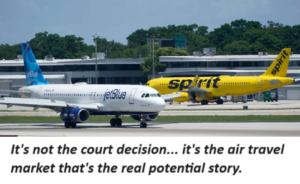 One of the most promising events in regard to increasing airline competition went 86 with JetBlue calling off the merger with Spirit. Apparently, proceeding with the appeal would have mostly benefitted legal fees, not the consumer.
One of the most promising events in regard to increasing airline competition went 86 with JetBlue calling off the merger with Spirit. Apparently, proceeding with the appeal would have mostly benefitted legal fees, not the consumer.
This is another indication that when it comes to understanding air transportation, let alone having a grip on cohesive, professional policy, the DOT is firmly mired in the 19th century.
__________
Florida Traffic: Changing Dynamics
Illuminating National Airline Strategy Trends
Relying on data from our friends at Cirium, it was of interest to take a look at Florida capacity, comparing the 2Q of 2024 to the same pre-CCP Covid quarter in 2019.
These data are only for the main players, and only for Florida-North America capacity. Breeze and Avelo were not in existence in 2019, so there’s no comparisons.
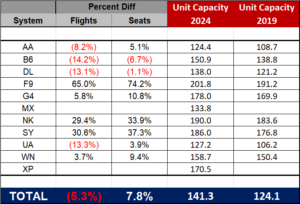 Of interest is that there are actually fewer flights, but on materially larger airliners. The average seat capacity was up almost 14% per departure. Only one of the four majors – Southwest – has an increase in flights. ULCCs were the growth vehicles. For now.
Of interest is that there are actually fewer flights, but on materially larger airliners. The average seat capacity was up almost 14% per departure. Only one of the four majors – Southwest – has an increase in flights. ULCCs were the growth vehicles. For now.
There is a take-away here that the resurgence of Florida air access is due mainly to ULCC capacity, and to fleet changes as all carriers continue to shift into larger units of capacity.
This type of trend data is important to watch, as fleet changes will be a major determinant of route decisions in the future.
Of note: if you compare the 2Q of 2023 with that of 2024, there is another emerging dynamic clearly coming into view: capacity flattening in Florida markets. This can be accessed in about 20 seconds via Cirium, and is a trend that airport market planners should grasp.
Fleet Uncertainty. On of the factors to watch in regard to changes in Florida capacity (and for that matter, capacity at Las Vegas and Phoenix) are potential capacity pull-downs due to the delays in aircraft deliveries due to the fiasco at Boeing and at RTX. Low yield markets will be taking a hit at least in regard to planned capacity increases.
Air service planning today is a whole lot more than churning out catchment and market studies. The foundational starting point is now understanding airline strategies and the events that affect them.
Want more understanding of the futurist approaches to air service planning? Give us a call.
_____________
Mobile United IAD Flights
Mobile has recruited nonstops to United’s Washington/IAD hub.
Mobile is the poster child for communities that are in the positive crosshairs of the new economic  development dynamics in the USA. The growing Airbus factory is making the region an aviation-centric growth area. The United service fills the demonstrated need for additional access to the EU as well as the East Coast.
development dynamics in the USA. The growing Airbus factory is making the region an aviation-centric growth area. The United service fills the demonstrated need for additional access to the EU as well as the East Coast.
Boyd Group International is honored to have crafted the successful Small Community Air Service Development grant that helped make this new service possible. We only accept SCASD projects when our hard futurist economic data indicate strong commercial value to both the community and the airport.
SkyWest Taking On 20 More E175s For United. The Message.
United will have SkyWest operate another 24 E175s in 2024. This is a fleet message that’s increasingly important to airport air service planning.
Point: the 70/76 seat fleets are growing at United Airlines. Smaller jet fleets are declining. In the USA there are just two operators of
This is a reality that’s too often missed in traditional air service development programs. The staring point for any small community air service program is no longer a “true market study” or “catchment analysis.” Airlines are not chasing markets based on these types of data.
It’s the mission capabilities of the fleets under their control. That’s now the first step. Blind shooting with data that have obsolete value isn’t going to get air service.
These E175s are far from net-new expansion airplanes for United. Due to issues at Boeing, the airline is going into 2024 with Boing unable to deliver 100 new 737s that were planned to be in the fleet.
Again: Air service access planning today must start with airlines and a clear grasp of industry trends.
________
Airline Retailing:
Where It Was. Where It’s Going.
Watch American Airlines.
American Airlines just announced that bookings made through certain travel agency portals will no longer be eligible for frequent flyer miles. No word on which of these portals will be affected, but take it to the bank, this is the beginning of the final step in deleting most off-carrier airline sales.
AA also is restricting some services to members of its frequent flyer program. It’s all about circling the revenue wagons.
In trying to opine where this may go, it’s instructive to see how airline retailing has evolved over the years.
Yikes. When we say “travel agent” for some of us, it recalls a dark medieval time when airlines were dependent on brick-and-mortar entities for a substantial part of passenger revenues. Not just dependent, but at their mercy.
Until the mid-1980s, the process of determining itineraries, booking reservations (often inter-line itineraries), computing fares manually, consulting massive tariff books, checking routing guides, applying joint fares on multi-airline trips, and writing out complex tickets, was an ordeal. So, airlines found that paying an outsider some percentage of the fare was cost-effective in retailing their product. It was a necessity, not necessarily something that they preferred to do.
But these travel agencies represented all carriers, and they were fully aware that they were in control of the consumer decision regarding what airline the customer would fly. They had no qualms using this as a sledgehammer pitting airlines against each other to get the bookings. The official airline pablum line was that travel agents were “our valued partners.” But the reality was that it was just a fragile truce – the TAs generally played the consumer-decision card openly and brazenly.
So, for an airline, the care and feeding of these agencies was critical and expensive. Airline sales reps were responsible for visiting and pandering to these agencies with all sorts of bennies in hopes they would be less likely to book folks on another carrier. Lots of “travel agency appreciation” receptions (cheap white zinfandel and shrimp seems to have been the feeding of choice), fam trips to far off places, and other incentives.
All done with the sincerity one usually finds only at a used car lot.
Travel agencies knew they had juice, and they generally did not hesitate to let airlines know it. One airline CEO referred to these people as “extortionists” – give’em what they want or else.
It was not uncommon for a TA to indignantly declare they’d never book another client on a specific airline in retribution for some failure to pay homage properly. Luckily, “never” was usually not much more than a week or so, or until the next cheap-wine-and-shrimp event. Short memories, usually.
But with the evolution of computerization, the end of interline routings, and automatic faring, by the mid-1980s, these agencies weren’t needed. Not at all. Consumers could do it on-line. Airlines could now advise the formerly-arrogant TAs that they could take a hike.
The complex training to read tariffs and fill out time-consuming conjunction tickets were no longer needed. Actually, tickets went away completely. The commissions ended. The travel agent help desk at the airline was disconnected. There were no more sales reps walking through the door with crocodile smiles. Airline retailing had left brick and mortal travel agencies in the past.
So, now we’re in an age when airline retailing is far more efficient, and in the control – mostly – of the airlines themselves.
That brings us to AA’s leadership in honing costs further. Bet on it, any part of the system where outsiders are involved in the airline choice (or choice of airline product) is going to be under scrutiny.
You have to assume that entities such as Travelocity and Expedia and others are in the crosshairs of the march of progress. Airlines have their own web portals, and maybe these other channels aren’t all that necessary. Or at least some of them. American has been upfront in making it clear that consumers who are AAdvantge members and who use AA.com have “status.” Sort of.
So, the battleground is where the costs v benefits may be in using outside retailers. AA dabbled with being off of some of these channels and went back. But Southwest seems to have survived okay, not being accessible on these channels.
The open question is what retail channels are the most cost-effective for the airline. One thing they’d like to avoid is having competition in the booking process. On these electronic travel agency portals, consumers have the ability to compare.
There’s another sea-change (sky-change?) in the works in regard to airlines busting out of anything traditional in retailing their product.
Stand by. Let’s see what Delta and United do over the next few weeks.
RIP Ultra Low-Cost Carriers:
Evolving Into AOCs:
Alternative Option Carriers.
This hoedown is clearly coming to an end. Or at least the party is moving elsewhere.
We are talking about the concept of the ultra low-cost carrier, which was focused on plumbing net-new traffic mostly by low fares to leisure points.
An Evaporating Market Strategy. The entire ULCC model was essentially based on being able to offer a new discretionary spend product – service to leisure and a few other markets where low fares could generate net-new impulse traffic.
That traffic is running dry. For two reasons.
One, it’s getting clear that markets such as Florida and Las Vegas and Phoenix are getting more capacity than can be stimmed but a cheap initial base fare.
The other is more ominous: the “U” in ULCC is evaporating fast. Cost advantages just aren’t as much in play as in the past.
New revenue streams are needed. Soon.
Think about it. ULCCs have no real advantage in fuel costs, or aircraft lease rates, or airport costs particularly as some continue to shift into major-density non-leisure markets. Labor costs are evening as well. New and expected gains across the bargaining table for pilots, flight attendants, maintenance and other classifications are leveling the cost ledger between ULCCs and major/hybrid airlines.
Take a look at the shifts in market strategy. Frontier is the most obvious example. It is pulling down capacity in Florida and Las Vegas. At the same time, they just announced a whole passel of expansion – into mostly major non-leisure markets – at PHL, DFW, MSP and CLT.
All, apparently, are markets where the incumbent’s high local fares could be in play. What Frontier is doing is offering an alternative air option. One with a much more bare product, a limited schedule, and fares lower than incumbents based on structural limitations on competitive responses.
The Key Is When The Incumbent Is Capacity-Trapped. It is going to take a lot more than an intro $19 fare to make these route print black ink. The local fares are high because in many – most – of the new markets targeted by F9 a lion’s share of the revenue is flow traffic over the major’s hubsite, and local O&D isn’t the main focus. In some cases, the incumbent may be reticent to fare-match for fear of spilling some of the more lucrative flow traffic over its hubsite.
So, the open question is determining the actual battle advantages of each player in these invaded hubsite local markets.
On one hand, there is the potential for F9 capturing some of the local O&D from the incumbent, due to the lower fares. In some of these markets, the incumbent major carrier is operating leased-in E175s, which have higher per-seat costs than the A320/321s Frontier will be operating.
Plus, these major airline flights tend to be at or above 80% load factors, giving little wiggle room for competitive response.
Again, this is particularly true when the majority of the passengers on the major are flow traffic that could be damaged in a local-market fare war.
Seat density – the last main expense refuge as other areas see increases – can be an advantage for F9, but they still must fill those 180-200+ seats, even with a day-of-week schedule, regardless of actual ASM costs.
Daunting. But Not Entirely Crazy. On the surface, by traditional thinking, what Frontier is doing is the airline equivalent of a bull moose charging an oncoming locomotive. The operative word here is “traditional” – that means old. That means – maybe – out of date.
The Stim Factor Is The Unknown. We took a look at Cirium data for one route involved – Grand Rapids-DFW. American enjoys an 80% load factor in the market with almost 230,000 passengers on board.
But over 65% of that high load factor is connect traffic over DFW, which is completely out of reach for Frontier. They will need to stimulate – or capture from AA and other incumbents, or both – a current local O&D traffic of about 91,000.
Okay, doing a fast pass at what F9 is planning, assuming three weekly A320 round trips DFW-GRR and assuming a need for an 80% load factor, the airline would need to board about 45,000 to make a go of it.
It leads to the conclusion that between diversion of some of the current O&D from American, and some stimulation due to lower fares (assuming they are still economic) this market entry may not be as daunting as it looks. Maybe. Grand Rapids is close to a boom market, as is most of Michigan’s Lower Peninsula. Point: this could actually work for Frontier.
The bottom line is this: for ULCCs to move into the future, it means moving some capacity into traditional and established markets where simply a low fare can both capture existing passengers and stimulate new ones. Lots of new ones. Their new niche needs to offer an alternative – a different product that can capture and stimulate traffic. It’s not direct competition, per se, but another product.
This means a whole new competitive picture, based on a model not yet proven. But it may be the only option left for the ULCC sector as cost advantages continue to be blurred.
The third quarter of 2024 should be really interesting.
________
Frequent Flyer Programs.
Some Big Changes Might Be Coming.
Back in October, two senators petitioned the Department of Transportation to investigate what they opined are anti-consumer actions on the part of airline frequent flyer programs.
Now, Buttigieg and crew are on it. Not good news, as it guarantees political grandstanding will come into play.
Cutting to the basic bottom line, the contention is that with airline affinity credit cards, consumers are awarded “miles” based on what they spend, whether it’s for travel or for groceries. That’s great.
The fly in the ointment is that the value and application of these miles gained in the spend process are at the mercy of airline decisions.
That, according to the thought patterns at the DOT, represents something close to bait and switch. Consumers spend, are awarded miles based on a reasonable expectation of their value. But when airlines can – and have – arbitrarily after the sale cut the value of these miles by increasing award levels, that could be considered as defrauding the consumer, at least by some.
Were it simply a matter of earning miles flown on the airline – which was the original program – the airlines’ contention that they can change these values at any time is clearly between them and their passengers. But when affinity credit cards are responsible for billions of spend, much based on consumers’ intent to acquire “miles,” then slashing the value of those miles takes another turn.
Let’s get clear here. The original intent of miles-derived frequent flyer programs was to build brand loyalty. Period. They were widely implemented to keep consumers from using another carrier.
For example, the American AAdvantage program was intended to attract passengers from Delta, United, Southwest, Continental, TWA, Braniff, Northwest, Ozark, North Central, USAir, Southern, and Texas International. Back then, airlines had plenty of seats available for award travel, and a gangbuster system load factor was 60%.
Let’s fast forward to today. All but American and the first three airlines listed are gone. No more. Not there. Plus, American, Delta, United and Southwest all have load factors in the roughly 80%-plus range. That means a lot fewer unsold seats to give away to award applicants. And possibly almost none except at off-peak times and circuitous routings to popular destinations.
Now, it doesn’t take an MBA from Wharton to conclude that it’s not good business to give away product that you can easily sell. So, that award chart now might be double or three times or more higher than five years ago.
Read: reducing the value of the miles earned when Fred Consumer uses his airline affinity card to pay for a burger and beer at the local gin mill is possible. Once awarded, there is no guarantee the value of those earned miles won’t be arbitrarily cut.
This does not make Fred real happy when he finds that after a couple of years charging everything on his Trans-Deficit Airlines Gold Card, the planned Hawaii trip with the kids is 50% more miles, and involves three connections to get to HNL from Omaha. (That is not an exaggeration.)
The conundrum facing airline FF programs is that the entire raison d’etre for them is gone, and now it’s the affinity cards that are the gold mine, instead of snarfing passenger demand from other airlines.
From that perspective, it is possible that the DOT and DOJ may have some legal leverage. Or think they do.
Ball is in the airlines’ court. They need to craft something beyond the claim that they have always made clear that the program is subject to change.
Fred thought he was getting a free trip. Now, maybe not. When he paid for that cheeseburger and beer, airline policies were not in play.
Standby.
January 29, 2024
Been a big week …
 The 737 Affair – It’s Not Just A Grounding.
The 737 Affair – It’s Not Just A Grounding.
It’s The Start of A Major Shift In The Airframe Industry
And It Will Affect USA Airport Planning
Lincoln, Nebraska just got word that United is yanking IAH service, starting in May.
This could be the first drive-by victim of the 737 fiasco at Boeing. United will have fewer airliners this summer than it had planned on. The service ends at the start of the summer – when a lot of expected airplanes will still be unbuilt.
It’s Just Starting. The Fallout Is Spreading Fast. The FAA has approved operations for the 737-9. But that does not address the cumulative damage inflicted on the air transportation system by this – only the latest – collapse of trust in Boeing.
Listen up, y’all. The Boeing issues have already changed airline route planning and air service access across the entire USA air transportation system. There’s more to come.
Let’s start with this: there is going to be a shortfall in planned airliners at United, Southwest, American, Alaska and Allegiant. Boeing is constricted by the FAA from increasing production rates. That means customers need to put off adding capacity, and maybe reconsider what they have on order from Boeing.
Airbus is licking their chops. Despite a full production dance card into the next decade, don’t assume that they are out of the picture as an alternative option for airlines which are the victim of Boeing’s issues. We’ll tackle that in a moment.
The production delays at Boeing are just the latest events that have resulted in Southwest taking out any assumptions that the 737-7 will be delivered in 2024. They have 300 on order. The carrier is working to knit-in the 18 new airports they unilaterally added in 2020-2021. The -7 was a part of that program. Operative word: was. This is a financial issue for WN.
United is delaying the scheduling of 737-10s, which is also facing certification delays. The airline has indicated it is now looking at alternative options. It has over 200 on firm order. Or, maybe not so firm.
Alaska Airlines has estimated a $150 million loss from the -9 grounding, which took 27% of its fleet and over 30% of its seats out of the sky. Oh, by the way, they have 50 737-10s on order, too. Or maybe did.
A Couple Hundred Order Shifts To Airbus? Airbus, which is the only other mainline narrow-body game in town, is production-booked until 2030. But that could change. The Boeing problems could – as a very raw estimate – shift as many as 500 or more 737 orders their way. That could well justify new facilities. As one option they have another 70 acres at Brookley/Mobile that is ready for expansion.
Embraer Out In The Cold? Embraer might have some new opportunities for the E190E2. Up until now, however, USA airlines have shown little interest in the platform, beyond the smaller scope-compatible E175 versions ordered for operation by “regional” contractors, which is not a sector that will be expanding – for economic and labor reasons.
Boeing Front-Office Credibility Is The Issue. Scott Kirby of United said it loud and clear. These -9 fiascos are just the latest in a stream of problems at Boeing, and as he put it, it was the straw that finally broke the camel’s back. He’s already paid a visit to Toulouse, according to reports.
Captain Dennis Tajer of the Allied Pilots Association noted that there is trust in the 737 as an airliner, but no trust in what’s coming out of Boeing management. Describing the Alaska incident being the result of a “quality escape” by Boeing executives was right up there with the “wardrobe malfunction” description of what happened several years ago at the Superbowl.
It was the kind of babble that comes out of those billion-dollar consulting cabals staffed by MBA escapees who couldn’t boil an egg without clear instructions.
Captain Tajer pointed out a stream of production failures on the MAX over the past two years, all similar to the loose bolts found on the -9. Not comforting.
Boeing Is Big. So, Too Will Be The Effects On The USA Economy. This entire situation has tentacles reaching into lots of aviation sectors. Air service planning will be affected not only by Boeing production delays and order cancellations, but by the costs imposed on the airlines themselves in trying to deal with the situation.
Suppliers to Boeing will be adversely hit. A slowed production line means slowed demand for components provided by contractors for the airplanes.
The FAA Will Be Under A Microscope. This party is a long way from over. Remember that the FAA is on the hot seat, too. They cannot, and now will not, allow politics to get involved.
Boeing is a major military contractor, with powerful connections on Capitol Hill. Their phone calls to these entities just might not get answered.
Based on the fact that lives have been at stake with the entire MAX program, it’s not entirely out of the question that Boeings “friends” inside the Beltway may take a powder on this one.
Message To Airports: Keep A Watch On Airline Schedule Filings. The shifts in airline route planning will likely be subtle, and embedded in glowing press releases announcing new service additions. But count on it: the red pencils are out and working in market planning.
More to come…
_________
An Observation.
In this earthquake of expected schedule revisions, airports need to assure that they can isolate and identify the effects of airline fleet strategy shifts.
 We’d add that we rely on Cirium for accurate and professional aviation data.
We’d add that we rely on Cirium for accurate and professional aviation data.
Changes will be coming, and it will take expertise and hard numbers to plan accordingly. Forecasting means defining the future before it becomes reality.
Airline schedule filings are your early warning system. Cirium delivers it.
___________-
_______
January 22, 2024
The Real Messages From The B6/NK Deal
It’s A Lot More Than Just A Court Case
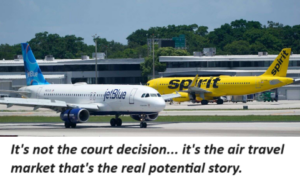 The JetBlue/Spirit Deal – The Messages from Outside the Courtroom
The JetBlue/Spirit Deal – The Messages from Outside the Courtroom
The message here isn’t just that a poorly informed judge turned the B6/NK agreement down.
It’s the repeated observations from credible analysts that both carriers may be facing a dive into the financial yogurt. And it isn’t due to a court decision – it’s an indication that the air transportation industry is in for a lot more turbulence than ambient information may indicate.
The entire air transportation system in which B6/NK and all other airlines operate is facing market changes that demand airlines shift expected strategies. Those shifts are not yet in full evidence.
We just got word that NK is projecting revenues on the high side of its prior guidance, but with a negative margin of something like 12%. JetBlue is now pulling down some flying, including leaving the BWI market, to shore up the bottom line.
These are decisions based on market conditions and are not entirely due to factors internal to the carriers themselves. If discretionary spending slows, which is the natural case with increased inflation, it will affect demand for air travel. And impulse travel – the foundation of the ULCC model – is at the outer margins of where these dollars are spent.
As it stands today, data from our friends at Cirium indicate that within the USA, airlines are planning to produce just under 5.5% more seats in 2024. Within this, the ULCC sector – again, which focuses on a different consumer travel sector than the four majors – is indicated to add close to 7.5%, if first quarter data is any indication.
But the fact remains that the Spirit performance – projecting a 12% negative margin – clearly indicates that the foundational economics of the ULCC sector are shifting out from under the sector. That expected 7%+ capacity increase may not play for the second half of 2024.
Recommendation: Watch for projected results in the 2Q of 2024. If Spirit and JetBlue are facing the need to cut capacity, the driver for this will be more than competition alone. If traffic demand continues to drive yields down, and the effects of new labor contracts come increasingly into play, it does not take a supercomputer to conclude that the ULCC sector will materially evolve.
With due respect to the folks in the financial world intimating things like Chapter 11, or even liquidation for either NK or B6, the real outcomes of this (should the carriers’ legal appeal be rejected) will more likely be that the carriers will materially restructure. In the case of Spirit, the declining metrics for the traditional ULCC market will be the cause.
Standby.
______
January 15, 2024
Rural Air Service:
The Southern Airways Model:
A Square Plug In A Square Hole
Avelo just pulled out of Dubuque. It was recruited subsequent to American leaving the market.
Presumably, the subsidy ran out. This is indicated by the drop in load factors from 90%+ to under 60% in September.
The ULCC Placebo For Air Access. Despite the hopes of the community, even if successful, Avelo could only deliver a single impulse-leisure destination for Dubuque. Great – if it had worked – but it still didn’t deliver air access to the community. That’s not the business Avelo is in.
A number of communities are in the same boat as Dubuque. They just don’t have the traffic demand horsepower by themselves to support the skyrocketing financial hurdle to support traditional network airline service. The main option is Cedar Rapids, about 75 minutes distant.
All the king’s market studies and all the king’s leakage analyses won’t change these geographic and economic realities. The issue is whether DBQ can develop scheduled air access that meets the needs of a limited and carefully-targeted business demand sector.
Enter what we call the Southern Airways model: limited and low-capacity nonstops to a major airline hubsite, with complete and transparent interline capability. This can be made possible when, a) the market is geographically with in the range of a Cessna 208 or similar, and b) is understood to be founded on specific business traffic that can and will use nonstops connecting at a specific airline hubsite.
No, it isn’t mass-transit flying. It is not intended nor can it be very low-fare service. It can work when there are specific sectors of the local business community have specific travel demand – mostly inbound – where a connection over a major hub and flying in a single-engine airliner can make sense.
For businesses from across the globe that may have communities of commercial interest with the DBQ region, this is an option that may have value.
On the table are Williamsport and Purdue. Both have specific business travel demand to which this type of service is valuable. Think the four professors from Japan who will be doing lectures at Purdue. Think the six component manufacturers coming from Mexico to negotiate with Lycoming’s offices at Williamsport.
Think specific and targeted travel demand. The hard fact is that markets like DBQ and TOL and YNG and others cannot compete on a full-out basis with other larger airports in their regions. So focus.
The Economics of Local Air Service Define Opportunities. We know this: the chances of Dubuque, or Youngstown, or Topeka, or several other similar airports attracting back mainline-branded E175s or CRJ700s are hair thin. In an airline system where fuel costs are going up, pilot pay is aimed at 30%-40% increases, and where similar jumps will be in cabin safety staff (a.k.a. flight attendants) and technicians, the economics for a lot of rural air service are simply out of reach.
Community Understanding of Air Service Realities Is Critical. Naturally, there are specific criteria necessary to make the Southern Model work, not the least of which is assuring the civic community is fully informed on air service realities, and not continually be swan-songed by Rasputin consultants with promises that continually lead nowhere.
These criteria were covered in our latest Touch & Go™ vision letter. If you’re not on the subscription list, drop us an email.
The point is that there may be solutions for opening business air access to points such as DBQ. But clinging to the hope that branded network service will return is fantasy.
________________
January 8, 2024:
What Would A Long-Term 737-9 Grounding Mean To Air Service?
It Is Unlikely, But, Let’s Think About It
The fallout from the Alaska incident, when an exit-door plug blew out after take-off from Portland, could have effects on not just Alaska and United (the only USA operators), but on dozens of communities across the nation.
Probably, a lot less effect on the national air transportation system than it may appear. At this point, the only airliner affected are 737-9s at Alaska and United. It’s a total of 144 airliners out of over 6,000 in USA airline service.
In the hopefully unlikely event a long term grounding is inflicted, both carriers would be facing some challenging re-structuring of schedules, disrupting thousands of flights and tens of thousands of passengers. But both carriers, particularly United, would adjust fairly quickly.
At UA, there are 79 737-9s in the fleet, with seven more on the order book. These aircraft represent only about 8.3% of United’s fleet, assuming that all are in active service, which is unlikely due to routine maintenance programs. More cogently, the 737-9 fleet comprises less than 12% of the carrier’s mainline narrow-body fleet.
The percentage of system ASMs these airliners represent is much smaller, but the real issue is dealing with flight schedule adjustments.
It would be tough, but taking into account the leased-in E175 lift in the United fleet, the airline would likely be able to readjust schedules relatively quickly for a long-term -9 grounding. Expensive, complex, and with reductions in some frequencies. But not a total body-blow to United’s customers.
Alaska Airlines is a different situation. The -9 fleet involved in this affair represent almost 30% of the operating AK fleet, which in the case of a longer-term grounding would entail some significant route system surgery. The most likely immediate move would be a slashing of significant percentages of the carrier’s trans-con markets in order to get aircraft time to support the rest of the AS system.
It would be a very real challenge for the carrier and some of the cities it serves.
It would likely result in diverting substantial E175 flying away from smaller markets, reducing frequency and possibly cessation of service entirely, depending on the length of the grounding.
All this tossed on the table, the NTSB preliminary findings should be out in the next week. If it does indicate a long-term (say, several weeks) grounding, then we’ll dive into a more granular analysis of the effects on air service.
__________
January 1, 2024:
Aviation Dynamics To Watch
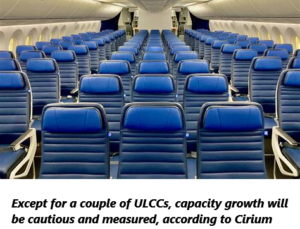 Airline Capacity:
Airline Capacity:
Majors Up 5.0% Over 1Q 2023.
ULCC Capacity All Over The Board.
Watch the first six weeks of 2024 to determine where the economy is headed. Nobody seems to be sure, depending on political viewpoint. So, consumer spending will be the metric. A metric that will determine growth or non-growth in air traffic.
According to our friends at Cirium, traditional mainline carriers are planning on a 5% increase over last year. ULCCs as a group are at @7.8%, but it’s all over the chart depending on airline.
On the mainline carrier side, some of the five per cent capacity increase is due to shifts in fleet mix, as more 50-seaters are sent to the desert.
But on the ULCC ledger – which comprises a fundamentally different airline business – the projections range from less than 2% growth (Allegiant) to almost 20% at Frontier. Percentage comparisons with Breeze and Avelo are not meaningful as both airlines were in start-up mode.
Airplane Order Books: Strategic Planning Indications. There are some telling data when fleet plans at ULCCs are compared, from over 200 new units on order (over several years) at Frontier to no hard future fleet numbers at Avelo, which still has just 16 737-700/800s operating.
For subscribers of the Touch & Go vision newsletter, we’ll be covering this in more detail at the end of the week.
___________
 Red Way Fiasco: Amateur
Red Way Fiasco: Amateur
Schemes & Plotting In ASD.
Hopefully, Lessons Learned.
The embarrassing fiasco of Red Way, which was a semi-charter attempt at Lincoln, Nebraska, just got more embarrassing. A state agency pilloried the scheme, describing it as a “riverboat gamble” and outlining how it never got within several galaxies of its glowing traffic projections.
Red Way was the embodiment of a lot of the amateur Pied Piper ASD consulting that’s being inflicted on some airports. Pander to and take advantage of local lack of knowledge of air service and consumer economics.
Routes were initiated and then dropped like flies right from the start. Load factors were akin to transporting sailboat fuel. The only thing that appeared positive was that Global X, the actual operator, was apparently a lot more reliable than the jive numbers the Red Way folks forecasted. In fact, the state report indicated that just one flight – the first one out of LNK – was profitable.
The number of $3.7 million is reported to be the tab. What is of concern is that most of the local comments revolve around hot air claiming it was a good try, it was a noble attempt. It was just the start. The community won’t be denied. Then the perfunctory new consultant hired arrives and suggests that American and Delta should be prime targets. Nothing like illuminating the obvious.
Red Way was a major failure in judgement and in planning. To romanticize it as noble is outrageous. It’s a poster child for the need for communities to learn about the economics and structure of the airline business before diving into civic-pride sideshows like this. Yessir, we need that service, is the mantra.
But having any inkling of the actual needs and trends of air consumers isn’t part of the program.
Hopefully this will be a message in 2024 that civic gung-ho is no substitute for responsible and professional air service planning.
_____________
 DOA?
DOA?
Airline Combinations, a.k.a. Mergers
JetBlue Acquiring Spirit. Do a media search, and virtually all of the articles paint the B6 acquisition of Spirit assets (no, it’s not a route merger) as being an attack on the consumer.
The me-too reporting – even in the supposed aviation sector – has been more trendy than accurate in regard to what this deal represents in regard to actually increasing competition.
Then toss in the incompetence at the top of the DOT, the nonsense from consumer gadflies, and probably zero active support from anyone in the Marble Playpen (congress) and the betting here is the deal loses. And so does the consumer.
Alaska/Hawaiian. This is really a change in ownership, not a combination of competing route systems. It can bring a lot of financial stability to the Hawaiian part of the system. Unfortunately, the “M” word (merger) is involved, and knees are jerking across the usual media. No hard projections here, but the ill-advised mergers of he 1980s (TW/OZ, NW/RP, AA/Air Cal, US/PI, etc.) are now being used as bogey-man warnings.
The industry has changed, and these four-decades old deals are non-sequiturs and not even relevant to the two airline deals on the table. But consumerist jihadists will likely get their way.
________________
 2024: DOT Jihad On Airline Customer Service.
2024: DOT Jihad On Airline Customer Service.
Airlines: Move To Make Flying Less of A
Customer Guessing Game.
Never assume that the folks at the top of the DOT will pass up anything they can use to put political spotlights on the airline industry.
There is no question that a lot of this is due to really short-sighted planning at some carriers. Namely, imposing all sorts of rules and fees and enforcement of same, often to be handled by gate staff that have less training than the guy operating the Slurpy machine at the local 7-11.
But that has generated a fertile field for both the media and the DOT to make press. We witnessed the sorry press conference a few months ago where Buttigieg and the occupant of 1600 Pennsylvania actually lied about a number of airline-imposed consumer issues. (Sorry if that statement offends anybody, as truth sometimes does.)
In 2024, unless the airline industry wants to have more regulatory interference which ultimately will harm consumers, it’s incumbent to assure that the air travel experience is simplified, de-ruled, and handled by trained and loyal staff. (That good deal in farming it out to Fred’s Ground Services is really a bad idea.)
Take a look at some of the coverage. There was the unfortunate one-off event where a six-year-old got boarded to the wrong destination. No argument, a giant service failure that could have had nasty repercussions.
But just this week, the media is burbling loudly about a 16-year-old kid that got on the wrong flight and ended up in San Juan instead of Cleveland.
A service failure, but a sixteen-year-old? The guy was old enough to drive himself to the airport. That’s not an unaccompanied minor, but the media coverage makes it look like the kid will be emotionally warped for life.
One network made this front-page above-the-fold website news, even to the extent of posting pictures of San Juan and of Cleveland to make the emotional point that the airline delivered him 2,000 miles away from Ohio. A 16-year-old kid, who according to the media had no responsibility for reading signs or hearing departure announcements or welcome announcements on the airplane.
Heck, when I was that age, I was fortunate to travel up and down the Pacific rim from our home in Taipei, often solo, without the benefit of a cell phone, internet or even a credit card. Scary and mind-warping it wasn’t. In this case, barring any mental challenges not mentioned in the panting articles, it is clear that this kid bears a lot of the responsibility.
The takeaway: air travel is a trendy treasure-trove for media attention. Most of it negative. The ball is in the airline industry’s court, but in some cases, there’s not much to be done to counter stupid media coverage.
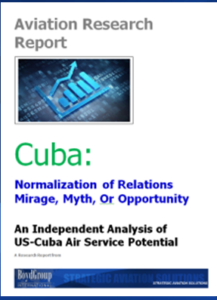



 ________________
________________

